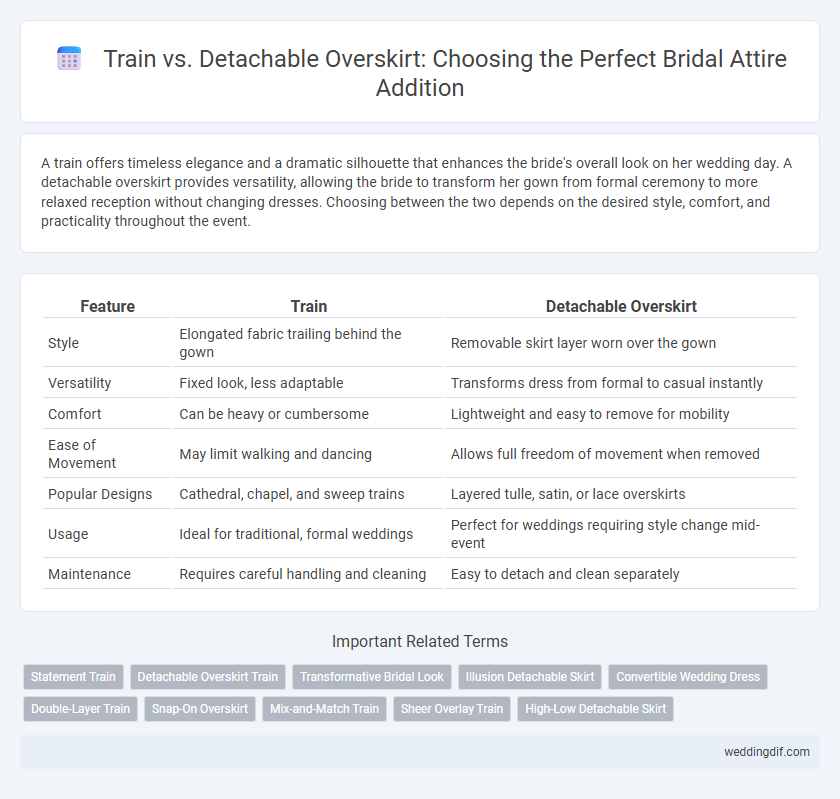A train offers timeless elegance and a dramatic silhouette that enhances the bride's overall look on her wedding day. A detachable overskirt provides versatility, allowing the bride to transform her gown from formal ceremony to more relaxed reception without changing dresses. Choosing between the two depends on the desired style, comfort, and practicality throughout the event.
Table of Comparison
| Feature | Train | Detachable Overskirt |
|---|---|---|
| Style | Elongated fabric trailing behind the gown | Removable skirt layer worn over the gown |
| Versatility | Fixed look, less adaptable | Transforms dress from formal to casual instantly |
| Comfort | Can be heavy or cumbersome | Lightweight and easy to remove for mobility |
| Ease of Movement | May limit walking and dancing | Allows full freedom of movement when removed |
| Popular Designs | Cathedral, chapel, and sweep trains | Layered tulle, satin, or lace overskirts |
| Usage | Ideal for traditional, formal weddings | Perfect for weddings requiring style change mid-event |
| Maintenance | Requires careful handling and cleaning | Easy to detach and clean separately |
Introduction to Wedding Dress Trains and Detachable Overskirts
Wedding dress trains extend elegantly behind the bride, adding dramatic length and a timeless silhouette that enhances formal ceremony aesthetics. Detachable overskirts offer versatile styling, allowing brides to transform their look from a voluminous gown during the ceremony to a sleek, manageable silhouette for the reception. Choosing between a traditional train and a detachable overskirt depends on the bride's preference for a classic or adaptable bridal appearance.
Key Differences: Train vs. Detachable Overskirt
A bridal train is a fixed extension of the gown that flows behind the bride, often made from the same fabric as the dress, creating an elegant and traditional silhouette. In contrast, a detachable overskirt offers versatility, allowing brides to transform their look from ceremony to reception by removing the overskirt for a more manageable or modern style. Key differences include permanence, functionality, and the ability to adapt the overall bridal attire between formal and casual aesthetics.
Aesthetic Impact: Elegant Silhouettes and Styles
Choosing between a train and a detachable overskirt significantly influences the bridal attire's silhouette and visual appeal. A train extends from the gown's hem, creating a flowing, dramatic effect that enhances elegance and traditional grandeur in styles like ball gowns or mermaids. In contrast, detachable overskirts offer versatile styling options, enabling brides to transform their look from formal and voluminous to sleek and modern, maintaining aesthetic impact while adding functional adaptability.
Practicality and Comfort: Mobility on Your Wedding Day
A detachable overskirt offers enhanced mobility and comfort by allowing brides to switch between dramatic and minimalist looks effortlessly throughout their wedding day. Traditional bridal trains, while visually stunning, can be cumbersome and restrict movement during reception activities. Choosing a detachable overskirt balances elegance with practicality, ensuring brides maintain ease of movement without sacrificing style.
Versatility: Transitioning from Ceremony to Reception
A detachable overskirt offers unparalleled versatility in bridal attire, allowing a seamless transition from a formal, voluminous look during the ceremony to a lighter, more mobile silhouette for the reception. Trains, while elegant and dramatic, can be cumbersome and limit movement, making the detachable overskirt a practical choice for brides seeking both style and comfort. This adaptability enhances the bridal experience by combining traditional grandeur with modern functionality.
Customization Options for Personalized Bridal Looks
A train offers a classic, dramatic extension to a wedding gown, customizable in length and style to complement various silhouettes and add elegance to bridal photos. Detachable overskirts provide versatile options, allowing brides to transition from a formal ceremony look to a more relaxed reception outfit with ease. Both elements can be tailored with intricate embellishments, fabrics, and layering techniques to create unique, personalized bridal ensembles.
Budget Considerations: Cost Comparison
Choosing between a train and a detachable overskirt in bridal attire significantly impacts the budget, with traditional trains generally incurring higher tailoring and fabric costs due to their length and complexity. Detachable overskirts offer a cost-effective alternative, providing versatility and the option to modify the bridal look without the added expense of extensive fabric and intricate sewing. Brides seeking elegance on a budget often prefer detachable overskirts for their affordability and adaptability without compromising style.
Popular Fabrics and Embellishments for Both Styles
Train and detachable overskirts in bridal attire commonly feature luxurious fabrics such as satin, tulle, and organza, selected for their elegant drape and volume. Embellishments like intricate lace appliques, Swarovski crystals, and pearl beadwork enhance both styles, adding texture and shimmer that complement the bride's overall look. Designers often combine delicate embroidery and sequins on these fabrics to create a dramatic yet refined aesthetic tailored to personal style preferences.
Bridal Fashion Trends: Train and Overskirt Popularity
Train designs and detachable overskirts have surged in popularity among contemporary bridal fashion, offering versatile style options for brides. Trains accentuate elegance with varying lengths like sweep, chapel, or cathedral, enhancing dramatic entrances, while detachable overskirts provide customizable volume and shape, enabling a seamless transition from ceremony to reception. Fashion-forward brides prioritize these elements for their blend of tradition and modern adaptability, reflected in top bridal collections and runway trends.
Choosing the Best Option: Factors to Consider for Brides
When choosing between a train and a detachable overskirt for bridal attire, brides should consider factors such as venue, mobility, and overall look. A train offers timeless elegance and dramatic effect, ideal for traditional ceremonies and large venues, while a detachable overskirt provides versatility and comfort, allowing easy transformation from ceremony to reception. Fabric weight, dress silhouette, and personal style also heavily influence which option will best complement the bride's vision and ensure a seamless wedding day experience.
Train vs Detachable Overskirt for Bridal Attire Infographic

 weddingdif.com
weddingdif.com